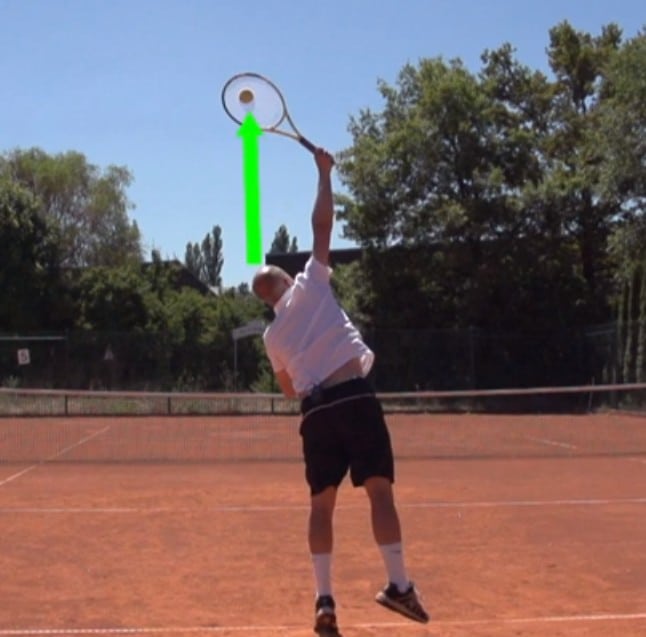The backhand is the shot that most tennis players fear the most. A weak backhand is very common and can often be a great liability. There are a few reasons why the backhand is often underdeveloped.
Usually players learn to hit forehands before they learn to hit backhands. This kind of gives the forehand a headstart. People get comfortable with the forehand before they start working on the backhand and therefore they prefer the forehand right from the beginning.
We will start with tips for the one-handed backhand.
Click Here To Go Straight To The Tips For The Two-Handed Backhand!
The One-Handed Backhand
Tennis Backhand Tip #1:
Develop A Straight Hitting Arm At Contact!
The most common mistake I see people make on the one-handed backhand is that they have a bent arm when contacting the ball. For the one-hander it is essential that your arm is straight when you contact the ball!
If you enjoyed this video tip go ahead and sign up for my newsletter right here. You will receive my Top5 Tips straight to your Inbox!
There are several bad things that can happen with a bent hitting arm on the one-hander. Probably the most important one is that those players are more likely to develop tennis elbow!
Looking at the flight path of the ball we can say that a bent arm will most likely result in the racket moving too far left to right and not enough forward and upward. The result are balls that land either short or wide.
Only with a straight hitting arm will you be able to develop the correct swing path and get effortless power on your one-handed backhand!
So to avoid this all too common problem I suggest you film yourself or have someone check if your arm is straight when you hit the ball. If it is not than you need to start working on it, ideally with lots of shadow-swings in slow motion to make sure you get the correction right!
Tennis Backhand Tip #2:
All great topspin groundstrokes have a very similar swing pattern and in this video tip I explain the basic swing pattern that you need to master the one-handed or two-handed backhand!
Tennis Backhand Tip #3:
Stay Sideways Throughout The Hit
The one-handed backhand is a shot that involves very little body rotation. All the great one-handers stay rather sideways throughout the hit. Especially around contact it is important to keep the upper body relatively still!
Too much rotation, similar to having a bent arm, usually results in balls that land either short or wide. Actually those two common problems are interrelated.
So what to do to avoid this problem ?
My favorite tips is to consciously focus on staying sideways throughout the hit and even after the hit. Again it is all about exaggerting the correct movement in the beginning. So start by hitting some balls and then stopping at the end to make sure your body is still sideways after the hit!
The more you exaggerate this in your practice sessions, the sooner it will become automatic so that you will do it correctly without thinking about it which is of course always the end goal!
The Two-Handed Backhand
Tennis Backhand Tip #1:
Uncoil Your Front Leg
For some reason most players have a tendency to stay down too low on the two-handed backhand. In order to make full use of the kinetic chain you need to learn to uncoil all of the important body segments, including the front leg.
Looking at great two-handers you will see that the players uncoil from the ground up which actually results in an upward motion of the body. You can see this very clearly by looking at the front leg which straightens out in most cases.
This is not possible on all balls and the pros don't do it all the time but they do it whenever possible and it is part of a fundamentally solid two-handed backhand.
So next time you go out and practice I recommend that you try this out and uncoil with your front leg straightening out towards the end of the hit. This will give you more power as well as more height over the net!
Tennis Backhand Tip #2:
Swing Inside-Out
Another common problem that I see on two-handed backhands is an outside-in swing path. What this means is that the racket starts the forward swing too far away from the body and then moves closer to the body.
Ideally any good groundstroke follows an inside-out swing pattern, meaning that the racket swings from close to the body at the beginning of the foreward swing to away from the body at contact. This way you can use your arm as a lever and create maximum power.
Andy Roddick is a famous example of an outside-in swing. Oftentimes a bad grip can be the cause of this common problem.
Assuming you don't have a bad grip (see my tennis lessons for more info on this) for now I recommend you go infront of a mirror and check out your swing. Do you swing inside-out or outside-in ? Sometimes the problem can be fixed just by realizing it!
So much for my favorite tennis backhand tips. More great tips coming soon!








